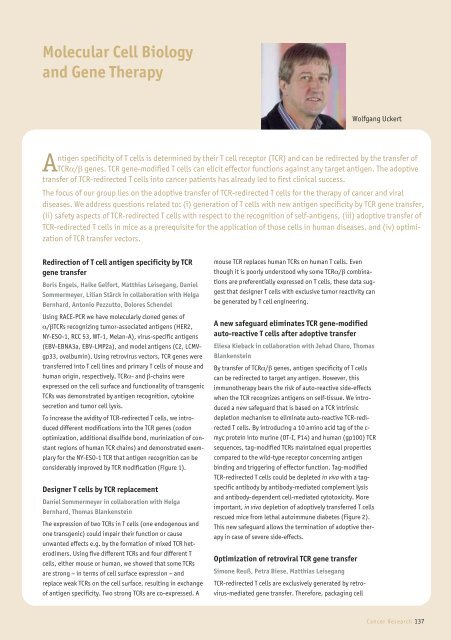of the Max - MDC
of the Max - MDC
of the Max - MDC
You also want an ePaper? Increase the reach of your titles
YUMPU automatically turns print PDFs into web optimized ePapers that Google loves.
Molecular Cell Biology<br />
and Gene Therapy<br />
Wolfgang Uckert<br />
Antigen specificity <strong>of</strong> T cells is determined by <strong>the</strong>ir T cell receptor (TCR) and can be redirected by <strong>the</strong> transfer <strong>of</strong><br />
TCRα/β genes. TCR gene-modified T cells can elicit effector functions against any target antigen. The adoptive<br />
transfer <strong>of</strong> TCR-redirected T cells into cancer patients has already led to first clinical success.<br />
The focus <strong>of</strong> our group lies on <strong>the</strong> adoptive transfer <strong>of</strong> TCR-redirected T cells for <strong>the</strong> <strong>the</strong>rapy <strong>of</strong> cancer and viral<br />
diseases. We address questions related to: (i) generation <strong>of</strong> T cells with new antigen specificity by TCR gene transfer,<br />
(ii) safety aspects <strong>of</strong> TCR-redirected T cells with respect to <strong>the</strong> recognition <strong>of</strong> self-antigens, (iii) adoptive transfer <strong>of</strong><br />
TCR-redirected T cells in mice as a prerequisite for <strong>the</strong> application <strong>of</strong> those cells in human diseases, and (iv) optimization<br />
<strong>of</strong> TCR transfer vectors.<br />
Redirection <strong>of</strong> T cell antigen specificity by TCR<br />
gene transfer<br />
Boris Engels, Haike Gelfort, Matthias Leisegang, Daniel<br />
Sommermeyer, Lilian Stärck in collaboration with Helga<br />
Bernhard, Antonio Pezzutto, Dolores Schendel<br />
Using RACE-PCR we have molecularly cloned genes <strong>of</strong><br />
α/βTCRs recognizing tumor-associated antigens (HER2,<br />
NY-ESO-1, RCC 53, WT-1, Melan-A), virus-specific antigens<br />
(EBV-EBNA3a, EBV-LMP2a), and model antigens (C2, LCMVgp33,<br />
ovalbumin). Using retrovirus vectors, TCR genes were<br />
transferred into T cell lines and primary T cells <strong>of</strong> mouse and<br />
human origin, respectively. TCRα- and β-chains were<br />
expressed on <strong>the</strong> cell surface and functionality <strong>of</strong> transgenic<br />
TCRs was demonstrated by antigen recognition, cytokine<br />
secretion and tumor cell lysis.<br />
To increase <strong>the</strong> avidity <strong>of</strong> TCR-redirected T cells, we introduced<br />
different modifications into <strong>the</strong> TCR genes (codon<br />
optimization, additional disulfide bond, murinization <strong>of</strong> constant<br />
regions <strong>of</strong> human TCR chains) and demonstrated exemplary<br />
for <strong>the</strong> NY-ESO-1 TCR that antigen recognition can be<br />
considerably improved by TCR modification (Figure 1).<br />
Designer T cells by TCR replacement<br />
Daniel Sommermeyer in collaboration with Helga<br />
Bernhard, Thomas Blankenstein<br />
The expression <strong>of</strong> two TCRs in T cells (one endogenous and<br />
one transgenic) could impair <strong>the</strong>ir function or cause<br />
unwanted effects e.g. by <strong>the</strong> formation <strong>of</strong> mixed TCR heterodimers.<br />
Using five different TCRs and four different T<br />
cells, ei<strong>the</strong>r mouse or human, we showed that some TCRs<br />
are strong – in terms <strong>of</strong> cell surface expression – and<br />
replace weak TCRs on <strong>the</strong> cell surface, resulting in exchange<br />
<strong>of</strong> antigen specificity. Two strong TCRs are co-expressed. A<br />
mouse TCR replaces human TCRs on human T cells. Even<br />
though it is poorly understood why some TCRα/β combinations<br />
are preferentially expressed on T cells, <strong>the</strong>se data suggest<br />
that designer T cells with exclusive tumor reactivity can<br />
be generated by T cell engineering.<br />
A new safeguard eliminates TCR gene-modified<br />
auto-reactive T cells after adoptive transfer<br />
Eliesa Kieback in collaboration with Jehad Charo, Thomas<br />
Blankenstein<br />
By transfer <strong>of</strong> TCRα/β genes, antigen specificity <strong>of</strong> T cells<br />
can be redirected to target any antigen. However, this<br />
immuno<strong>the</strong>rapy bears <strong>the</strong> risk <strong>of</strong> auto-reactive side-effects<br />
when <strong>the</strong> TCR recognizes antigens on self-tissue. We introduced<br />
a new safeguard that is based on a TCR intrinsic<br />
depletion mechanism to eliminate auto-reactive TCR-redirected<br />
T cells. By introducing a 10 amino acid tag <strong>of</strong> <strong>the</strong> c-<br />
myc protein into murine (OT-I, P14) and human (gp100) TCR<br />
sequences, tag-modified TCRs maintained equal properties<br />
compared to <strong>the</strong> wild-type receptor concerning antigen<br />
binding and triggering <strong>of</strong> effector function. Tag-modified<br />
TCR-redirected T cells could be depleted in vivo with a tagspecific<br />
antibody by antibody-mediated complement lysis<br />
and antibody-dependent cell-mediated cytotoxicity. More<br />
important, in vivo depletion <strong>of</strong> adoptively transferred T cells<br />
rescued mice from lethal autoimmune diabetes (Figure 2).<br />
This new safeguard allows <strong>the</strong> termination <strong>of</strong> adoptive <strong>the</strong>rapy<br />
in case <strong>of</strong> severe side-effects.<br />
Optimization <strong>of</strong> retroviral TCR gene transfer<br />
Simone Reuß, Petra Biese, Matthias Leisegang<br />
TCR-redirected T cells are exclusively generated by retrovirus-mediated<br />
gene transfer. Therefore, packaging cell<br />
Cancer Research 137
















